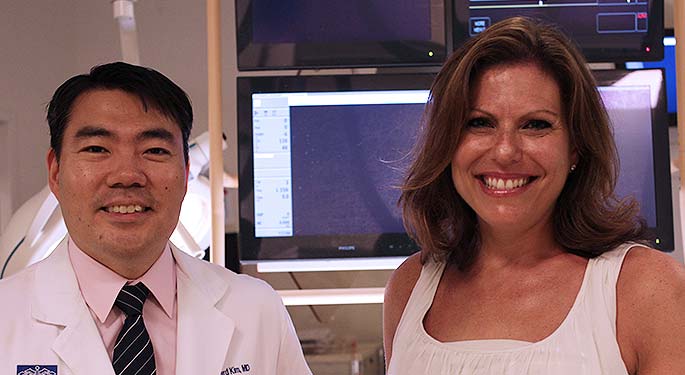Blood Clots

Deep Vein Thrombosis (DVT) is a condition that causes blood to clot in the deep leg vein.
Varicose veins are blood vessels that are stretched and damaged. They can cause your blood to collect in one spot in your veins. Often, you can see the pool just below the skin. The condition affects about half of all Americans as we age.
Treatments We Offer
At Mount Sinai, we use a variety of minimally invasive procedures to treat blood vessel conditions. These outpatient procedures allow for a quicker recovery, less pain and scarring, and fewer side effects. Our interventional radiology treatments include:
- Pharmacomechanical catheter-directed thrombolysis (PCDT) treats DVTs. We inject a clot-busting drug (such as tPA) directly into the blood clot. Then, we use a specially designed, catheter-mounted device to remove the clot fragments.
- Endovenous laser treatment (EVLT) helps with varicose veins. We insert a small catheter into the vein in your leg. Energy from the laser kills the damaged portion, allowing the enlarged vein to shrink. This treatment takes 30 to 60 minutes. Most people return to normal activities immediately afterward.
- Sclerotherapy treats varicose, spider, and reticular veins. During the treatment, we inject a chemical substance, called a sclerosant, directly into the affected vein. The chemical causes the affected veins to collapse. The veins can then no longer fill with blood. So, they close off and are reabsorbed by the body over several weeks to months. If you receive this procedure for cosmetic reasons, you may notice significant improvement in the look and feel of their legs following treatment.
- Ambulatory phlebectomy is a minimally invasive way to remove surface varicose veins. We perform it in our office with a local anesthetic. Then we use a needle to puncture a spot close to the vein. We insert a small hook into the needle hole so we can grab and remove the varicose vein. Scars are almost impossible to see. We often perform this procedure along with an endovenous laser treatment.
IVC Filter Retrieval
Inferior vena cava (IVC) filter removal is the process in which an IVC filter that had previously been placed in a patient is removed. To do so, our interventional radiologists make a small incision and insert a small thin tube (catheter) into the large vein in your neck. Guided by X-ray imaging, we grasp the hook on the end of the filter and pull it out. We use local anesthesia to perform this outpatient procedure. Most IVC filters are easily removed while some IVC filters will require advanced retrieval techniques.
Why Mount Sinai
We are nationally known for our expertise in treating blood vessel problems. Along with skill and experience, we offer compassionate and individualized care.
In addition, we are involved with several clinical trials in interventional radiology of the blood vessels. Our patients can participate in these trials, gaining access to the very latest treatments. The studies we are involved with include:
- A national study of image-guided clot removal treatments to prevent post-thrombotic syndrome
- The ATTRACT Trial, which studies clot-busting treatments. We are the only site in New York City participating in this clinical trial.